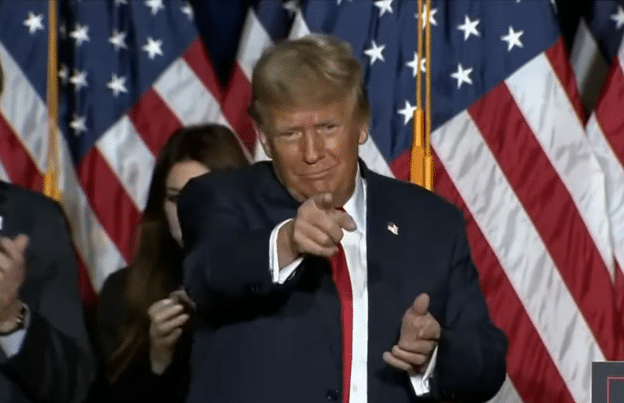
November 21, 2024
Permission to republish original opeds and cartoons granted.
Trump’s Mandate: Why The Popular Vote Mattered In 2024
| 
|
|
It is now more than two weeks after the Nov. 5 election that swept President-elect Donald Trump back into office and saw Republicans retain the House majority and reclaim the Senate, completing the trifecta with one notable addition Republicans have not seen since 2004: The presidential candidate, Trump, won the popular vote. As of now, Trump is garnering 76.7 million out of almost 153.46 million votes cast, or about 49.99 percent, and Vice President Kamala Harris registered 74.18 million, or 48.34 percent, about a 1.6 percentage edge for Trump. Some states like California are still counting so the final tally is not yet available. And yet, everyone wants to know, is it a mandate for Trump to enact the policies he openly campaigned on as it pertains to illegal immigration, building the wall, staying tough on trade, enacting tax relief and so forth? In the U.S., legitimacy is conferred by the consent of the governed, and constitutionally, this means winning the Electoral College as president. A further mandate can also be conferred by winning the popular vote. And an even further mandate can be conferred by the President’s party winning the House and the Senate, too, the so-called trifecta. Trump and his party got all three: the Electoral College, the popular vote and the trifecta. That’s a mandate. |
Trump’s Mandate: Why The Popular Vote Mattered In 2024

By Robert Romano
It is now more than two weeks after the Nov. 5 election that swept President-elect Donald Trump back into office and saw Republicans retain the House majority and reclaim the Senate, completing the trifecta with one notable addition Republicans have not seen since 2004: The presidential candidate, Trump, won the popular vote.
As of now, Trump is garnering 76.7 million out of almost 153.46 million votes cast, or about 49.99 percent, and Vice President Kamala Harris registered 74.18 million, or 48.34 percent, about a 1.6 percentage edge for Trump. Some states like California are still counting so the final tally is not yet available.
This was accomplished by Trump overperforming pretty much everywhere compared to his showings in 2016 and 2020, doing better than ever in traditionally Republican states, but also in Democratic states. For example, Trump only lost New Jersey by six points, compared to 16 points in 2020.
At this point, within the rounding, pretty much half of the country voted for Trump. When you consider Robert Kennedy, Jr. — who Democrats fought to keep on the ballot in Michigan and Wisconsin, garnering 26,847 and 17,681 votes, respectively — if Kennedy, who endorsed and campaigned with Trump, had succeeded in removing his name in just those two states, it’s arguable whether they would have gone to Trump or if they would have stayed home. Even some combination of the two once again would have put Trump above 50 percent.
Some commentators might wish to make hay out of Trump not getting above 50 percent. He would join John Quincy Adams, James Polk, Zachary Taylor, James Buchanan, Abraham Lincoln in 1860, Rutherford B. Hayes, James Garfield, Grover Cleveland (both times), Benjamin Harrison, Woodrow Wilson (both times), Harry Truman, John Kennedy, Richard Nixon in 1968, Bill Clinton (both times), George W. Bush in 2000 and Trump in 2016 as presidents who won the Electoral College but not an absolute majority of the popular vote.
Of those, Trump’s 2024 showing at 49.99 percent is actually the best of all of them.
Usually, a president who wins the election but not an absolute majority of the popular vote, when this occurs, has a lot less to do with mandates than there being significant third parties on the ballot. This time, they comprised about 1.7 percent of the vote, whereas Trump’s margin of victory was 1.6 percent.
The third parties potentially were more than enough to shift the popular vote one way or another but not the Electoral College, with Trump winning absolute majorities in Pennsylvania, North Carolina, Georgia, Arizona and Nevada. Michigan and Wisconsin were less than 50 percent for Trump, but Kennedy not being on the ballot might have changed those, too, we’ll never know.
As the saying goes, a win’s a win, and the popular vote still matters, arguably even more for Republicans than Democrats, with the GOP having lost the popular vote in 2000, 2008, 2012, 2016 and 2020. It was quite a drought and fed a growing certainty of a permanent Democratic majority. Would Republicans eventually be swamped in the Electoral College, too, cementing one-party rule for a generation?
That illusion is now broken. After all, neither Al Gore nor Hillary Clinton got a majority of the popular vote in 2000 and 2016 in their Electoral College defeats to George W. Bush and Trump, respectively. And yet, the split decision in both elections were wielded politically to undermine and question the legitimacy and mandate of both outcomes, with Gore’s Florida recount and with Clinton’s Russiagate fabrications.
Now, with the national win and the Electoral College win, there are no such challenges being waged against Trump, who will enter his second and final term as president on Jan. 20.
Republicans can now breathe a sigh of relief and see how to keep their new electoral coalition together, and preferably from their standpoint, growing.
And yet, everyone wants to know, is it a mandate for Trump to enact the policies he openly campaigned on as it pertains to illegal immigration, building the wall, staying tough on trade, enacting tax relief and so forth?
In the U.S., legitimacy is conferred by the consent of the governed, and constitutionally, this means winning the Electoral College as president. A further mandate can also be conferred by winning the popular vote. And an even further mandate can be conferred by the President’s party winning the House and the Senate, too, the so-called trifecta. Trump and his party got all three: the Electoral College, the popular vote and the trifecta.
That’s a mandate, and one which will be further assessed in 2026 when the Congressional midterms come and Republicans attempt to defend a very meager House majority and a 53 to 47 seat majority in the Senate, and then once again in 2028 when Vice President J.D. Vance might be the presumed GOP nominee. Losses in a midterm for the incumbent party are normal, and so 2028 will be the true test. Once again, Republicans have a majority, if they can keep it.
Robert Romano is the Vice President of Public Policy at Americans for Limited Government Foundation.
To view online: https://dailytorch.com/2024/11/trumps-mandate-why-the-popular-vote-mattered-in-2024/
Cartoon: Right Vs. Swamp

By A.F. Branco
Click here for a higher level resolution version.
To view online: https://dailytorch.com/2024/11/cartoon-right-vs-swamp/
